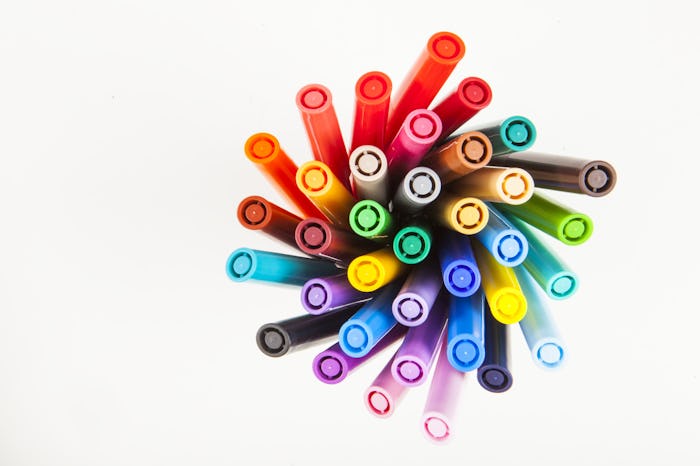Life

This Mom's Viral Dried-Out Marker Hack Will Clean Out Your Drawers & Save The Planet
There's something super relatable about a mom with a tattered plastic baggie of Crayola markers, half of which have inevitably been left uncapped and are now dry as a bone. No matter how many marker-capping lessons you teach, you're always gonna find a few crusty AF markers at the bottom of the bag – that's just life. However, wait a second before you toss them in your trash can — or, if you're like me, lazily leave them in the bag forever. It turns out, Crayola recycles old markers through their ColorCycle program. Throw them in a cardboard box, slap on one of their printable shipping labels, and send them off — Crayola makes saving the planet that easy.
I'd love to say I'm a super-proactive environmentalist who's been doing this for years, but I'll give credit where credit is due. I discovered Crayola's ColorCycle program through Facebook user Hali McCloud, whose post about the program went viral. For McCloud, who lives with her family in Hawaii, recycling these markers is of the utmost importance. She writes, "15 pounds of dead markers that will not end up in Maui’s landfill or ocean. Did you know that Crayola has a program called ColorCycle? If you collect the dead markers, they’ll send you a free shipping label and you can ship them back to Crayola to be recycled!"
So, how exactly does it work? According to the Crayola website, ColorCycle is an initiative in which "students in K-12 schools across the continental United States and parts of Canada can collect and repurpose used Crayola markers." In other words, you've got to get your local schools on board — but that shouldn't be too difficult, since it's good for the environment, beneficial for children to learn about, and completely free. Print off a stack of the "Parent Advocate Letters" from the ColorCycle website, which invites parents to bring in markers from home for recycling, and ask the school to pass them out in their classrooms.
Then, all you need to do is set up some large boxes in the school's common area, and hang up one of ColorCycle's printable signs to indicate what the boxes are for. McCloud writes, "My kids found out about this and were so excited to set up boxes at their schools." Enlist your kids to help — they'll feel important and excited to help spearhead a project.
Once you've collected a fair amount of markers, it's time to ship them off. You'll need to count the markers you've collected, so I'd recommend gathering some helpers if you've received a lot of donations. Pack your markers in a cardboard box, and then head to the ColorCycle page to print out a free shipping label. FedEx can pick up the markers (or you can drop it off at a local FedEx) and you're done. Crayola foots the bill for all shipping costs — except in Alaska or Hawaii, as of right now — so you don't have to worry about that.
In my opinion, one of the coolest aspects about this program is that Crayola will actually accept any brand and any type of plastic marker. By accepting all types of markers, highlighters, and dry erase markers, ColorCycle massively reduces the amount of plastic markers being sent to landfills. I've thrown away a shameful amount of old markers in my life, and thinking about them all sitting in landfills gives me the heebie-jeebies. Thanks to Crayola's program (and Hali McCloud's eyeopening Facebook post), we can start all start doing the right thing from here on out. Clean out that tattered old marker bag, and help the planet while you're doing it.